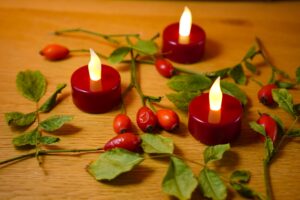So much has been written about the amazing properties of – its ability to calm the nerves, aid relaxation, help give you a good night’s sleep, as well as its healing benefits.
Well I thought I’d do my best to write something about what is actually in lavender oil. Be warned, there’s no dramatic “tah-dah, this is the magic ingredient” revelation, more a general description of some of the main ingredients.
Even so, it gets a bit chemistry-nerdy, but hopefully you’ll persevere and find it interesting.
It’ a bit of a subject so the first part of this is how do we know what’s in lavender oil, and the second part is more of what is actually in the oil.
There is a wonderful process call gas chromatography (GC). Basically this is a much more sophisticated version of that experiment that you might have done at school when you put blob of ink on blotting paper and stood it in some liquid.
As the liquid moved up the paper it sort of dragged the ink with it but at the same time separated it out into a variety of different colours.
With the process of GC the lavender oil (you only need a millionth of a litre – not a lot!) is put into one end of a long, fine tube and as it is pushed through by a gas (it’s done at high temperature as well) it is separated into all it’s different chemical components.
The next step is to identify those components as they come out of the end of the tube. There are a variety of ways of doing this but a commonly used is a technique called mass-spectroscopy (MS).
This is pretty techie stuff but in short it allows you to identify all those different chemical components in lavender oil by the amount they are affected by a magnetic field. This is related to the weight (mass to you chemists) of the component and the electrical charge on it.
Simple. No. It’s specialist stuff, needs some expensive kit and someone who knows what they are doing and how to “read” the data.
At the end of the analysis, you end up with a graph that looks a bit like the one on the left (each spike on the graph is one component) and a list of the chemical components and their percentage levels in the lavender oil.
So, what does this analysis tell you? The most obvious thing is how complicated lavender oil is. Possibly up to 100 different chemical components, all produced by the lavender plant as part of it’s everyday bio-chemistry.
Life is complicated, and I’m sure every single one of those components somehow serves a vital purpose for the plant.
One thing to immediately notice if you analyse lots of lavender oils – and here I’m only really talking about the oil from lavandula angustifolia (“English” lavender, lavender officinalis, “True” lavender) – is how different they all are.
These variations are due to lots of factors – variety of lavender, soil, growing conditions, climate, harvest & distillation process and storage. They will all smell like lavender oil, but when you line them all up, look at them and smell them in comparison with each other, then differences will be obvious.
So what are the main components? Lavender oil is made up mainly from two components – Linalool and Linalyl Acetate. These two are often found together since one is readily turned into the other, and they can make up from 55% to 90% of the oil, but more typically around 70%.
There is usually slightly more Linalyl acetate and on its own smells floral, bergamot, petitgrain.
The Linalool smells floral, sweet and slightly rosey with a touch of spice.- in tests has been shown to reduce stress, and there is some evidence that it can kill cancer cells. It is found in other plants such as laurel, basil, and rosewood.
The levels and ratio of these components are often quoted in the specification of lavender oil, and in fact you will come across an oil called lavender 40:42. If you find this on a website selling “pure” essential oils, go elsewhere.
Lavender 40:42 is a good perfumery quality of oil, but has been mixed with synthetic linalol and linalyl acetate to bring the levels of these components to 40 and 42 percent. It may smell nice, but it isn’t wholly natural.
Next most abundant are a whole host of components that can usually make up only a few percent each:
Camphor – has a strong, fresh, smell that “clears the nose”. It is often used in vapour steam products to help breathing and decongest. Higher levels of camphor are found in oil of lavandula x intermedia -often called lavandin. Camphor is also used as a moth repellant. Oil of lavandin “Grosso” is also produced at the Jersey Lavender farm. Once upon a time camphor was extracted from the wood of the camphor laurel (Cinnamomum camphora), a large evergreen tree found in Asia (particularly in Borneo and Taiwan), but these days the vast majority is synthetically produced.
3-Octanone – has a sweet, banana, berry smell.
Terpinen-4-ol – has an earthy, fresh, green, musty smell and is thought to be the active antibacterial component in Tea Tree oil.
1,8 Cineol – otherwise known as eucalyptol, since it is the main component of eucalyptus globulus oil. It has a strong fresh, clean eucalyptus-like fragrance.
And then of course, there are lots of other components in tiny quantities, such as caryophylene, germacrene, ocimene, humalene, geranyl acetate, borneol, and many others.
It is these that give natural lavender oil it’s depth and richness, and make the difference between synthetic oils and natural oils.
Since the bulk of lavender oil is made up of so few materials, it is possible of course to “reconstitute” lavender oil using the synthetic chemical components, and indeed you do get something that is both cheap and smells lavender.
If a perfumer is creating a lavender fragrance for a cheap floor cleaner, then this is often what they will use, and not the more expensive natural oil.
However, sometimes, I have no doubt that through crookery or ignorance these synthetic blends do make their way to market, being passed off as natural oil. My blog post Lavender Oil: sometimes, all is not quite what it seems expands on this.
If you have any comments or questions, I’d be happy to do my best to answer them.
Note: The author Alastair Christie runs Jersey Lavender, and studied Chemistry at university. He is however, many years on, a rather rusty chemist and apologises to any super-chemists out there who think he’s done a poor job of describing GCMS!!!
Read related articles:





